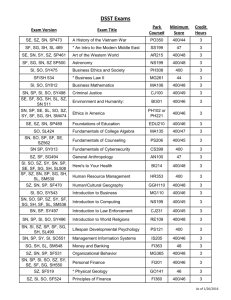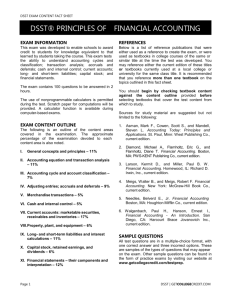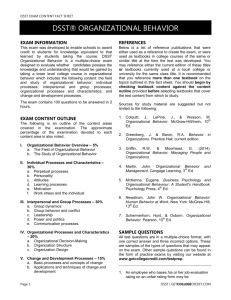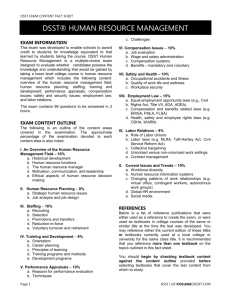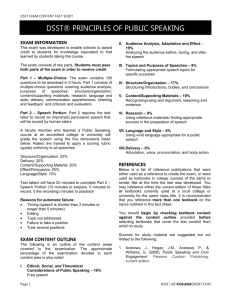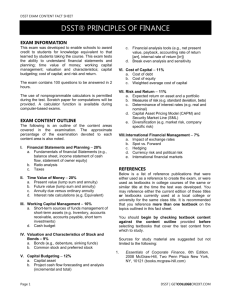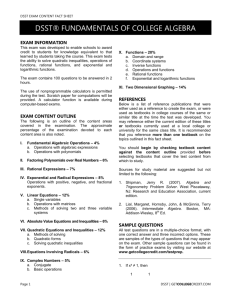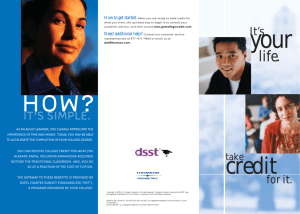DSST® TECHNICAL WRITING
advertisement
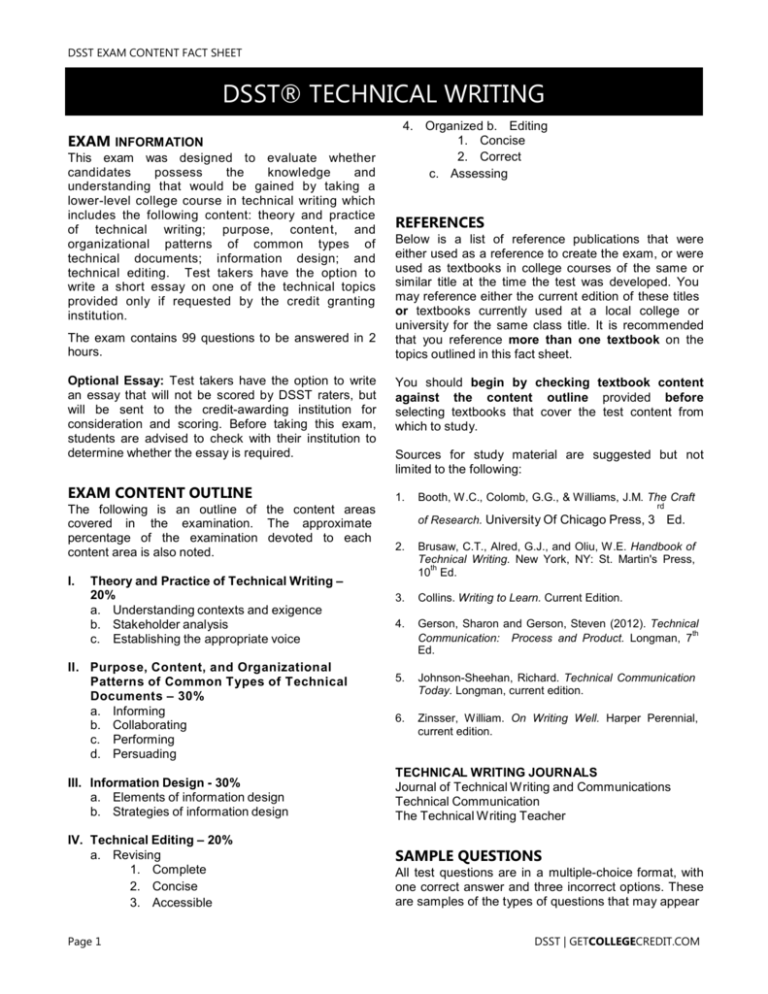
DSST EXAM CONTENT FACT SHEET DSST® TECHNICAL WRITING EXAM INFORMATION This exam was designed to evaluate whether candidates possess the knowledge and understanding that would be gained by taking a lower-level college course in technical writing which includes the following content: theory and practice of technical writing; purpose, content, and organizational patterns of common types of technical documents; information design; and technical editing. Test takers have the option to write a short essay on one of the technical topics provided only if requested by the credit granting institution. The exam contains 99 questions to be answered in 2 hours. Optional Essay: Test takers have the option to write an essay that will not be scored by DSST raters, but will be sent to the credit-awarding institution for consideration and scoring. Before taking this exam, students are advised to check with their institution to determine whether the essay is required. EXAM CONTENT OUTLINE The following is an outline of the content areas covered in the examination. The approximate percentage of the examination devoted to each content area is also noted. I. Theory and Practice of Technical Writing – 20% a. Understanding contexts and exigence b. Stakeholder analysis c. Establishing the appropriate voice II. Purpose, Content, and Organizational Patterns of Common Types of Technical Documents – 30% a. Informing b. Collaborating c. Performing d. Persuading III. Information Design - 30% a. Elements of information design b. Strategies of information design IV. Technical Editing – 20% a. Revising 1. Complete 2. Concise 3. Accessible Page 1 4. Organized b. Editing 1. Concise 2. Correct c. Assessing REFERENCES Below is a list of reference publications that were either used as a reference to create the exam, or were used as textbooks in college courses of the same or similar title at the time the test was developed. You may reference either the current edition of these titles or textbooks currently used at a local college or university for the same class title. It is recommended that you reference more than one textbook on the topics outlined in this fact sheet. You should begin by checking textbook content against the content outline provided before selecting textbooks that cover the test content from which to study. Sources for study material are suggested but not limited to the following: 1. Booth, W.C., Colomb, G.G., & Williams, J.M. The Craft rd of Research. University Of Chicago Press, 3 Ed. 2. Brusaw, C.T., Alred, G.J., and Oliu, W.E. Handbook of Technical Writing. New York, NY: St. Martin's Press, th 10 Ed. 3. Collins. Writing to Learn. Current Edition. 4. Gerson, Sharon and Gerson, Steven (2012). Technical th Communication: Process and Product. Longman, 7 Ed. 5. Johnson-Sheehan, Richard. Technical Communication Today. Longman, current edition. 6. Zinsser, William. On Writing Well. Harper Perennial, current edition. TECHNICAL WRITING JOURNALS Journal of Technical Writing and Communications Technical Communication The Technical Writing Teacher SAMPLE QUESTIONS All test questions are in a multiple-choice format, with one correct answer and three incorrect options. These are samples of the types of questions that may appear DSST | GETCOLLEGECREDIT.COM DSST EXAM CONTENT FACT SHEET – TECHNICAL WRITING on the exam. Other sample questions can be found in the form of practice exams by visiting our website at www.getcollegecredit.com/testprep. Questions on the exam require test takers to demonstrate the following abilities. Some questions may require more than one of these abilities. • • • knowledge of basic facts and terms (about 3545% of the examination) understanding of concepts and principles (about 30-40% of the examination) ability to apply knowledge to specific problems and situations (about 25-35% of the examination) 1. It is customary to place definitions of terms in all of the following parts of a technical document EXCEPT the a. abstract b. introduction c. footnotes d. glossary 2. Which of the following organizational patterns would be appropriate to use when describing a mechanism? I. Order of assembly II. Spatial order III. Operating order a. b. c. d. II only III only I and III only I, II, and III 3. Which of the following graphics is best for displaying continuous change over time? a. Bar chart b. Line graph c. Schematic diagram d. Table 4. The major difference between proposals and many other technical documents is that proposals are a. long and formal b. written by committees c. overtly persuasive d. presented orally as well as in writing 5. Laboratory reports customarily contain all of the following sections EXCEPT a. materials and methods b. results c. discussions d. recommendations 1) The rabbits did not build up as much fat in the walls of their arteries as expected. 2) One group was left unattended except at feeding time, while the other received some old-fashioned tender loving care (TLC) every day for at least one hour. 3) Researchers at Ohio State University made an unexpected finding while feeding a group of rabbits high-cholesterol diets in preparation for an experiment. 4) The TLC rabbits developed only one-third as many fatty deposits as the others. 5) Investigating further, the team fed high doses of cholesterol to two new groups of rabbits. 6) One researcher mentioned that she had given these rabbits special treatment, greeting and cuddling each four to five times a day. 6. If the sentences are arranged into a coherent paragraph, which sentence will come third in the sequence? a. 1 b. 2 c. 5 d. 6 7. If the sentences now numbered 1 and 6 were combined into one sentence, the new sentence would begin with which of the following? a. When b. Although c. Because d. Thus 8. One significant difference between technical language and lay language is that technical language tends to be more a. subjective b. sophisticated c. abstract d. exact 9. Which of the following is a major flaw in a classification? a. overlap in the categories b. use of the same criterion throughout c. division into more than ten groups and subgroups d. categories with different numbers of subdivisions 10. Which of the following does NOT need revision to correct an error in parallel structure? a. We found it impossible either to replicate their results or even approximate them. Questions 6-7 refer to the following group of numbered sentences: Page 2 DSST | GETCOLLEGECREDIT.COM DSST EXAM CONTENT FACT SHEET – TECHNICAL WRITING b. The ideal environment for colonizing plants like ragweed is bare, windswept, and, of course, contains little groundwater. c. The platypus is an animal with mammalian, reptilian, and avian aspects and which illustrates the difficulty of exact biological classification. d. The proposed pertussis vaccine not only is as effective as the vaccine currently in use but also poses little or no health risk to children under two years of age. In each of the following sentences, some part of the sentence or the entire sentence is underlined. Beneath each sentence you will find four ways of phrasing the underlined part. The first choice (a) repeats the original; the other three are different. If you think the original is better than any of the alternatives, choose answer (a). Otherwise, choose one of the others. In choosing answers, pay attention to grammatical correctness, appropriate word choice, and smoothness and effectiveness of sentence construction. 11. Ibuprofen is a powerful pain reliever and it has only recently been made available to the public in nonprescription doses. a. Ibuprofen is a powerful pain reliever and it has only recently b. Ibuprofen, a powerful pain reliever, has only recently c. Ibuprofen is a powerful analgesic that only has recently d. Only the potent analgesic ibuprofen has recently CREDIT RECOMMENDATIONS The American Council on Education’s College Credit Recommendation Service (ACE CREDIT) has evaluated the DSST test development process and content of this exam. It has made the following recommendations: Area or Course Equivalent Level Technical Writing Amount of Credit Minimum Score Three (3) semester hours Source American Council on Education – College Credit Recommendation Service Lower-level baccalaureate 400 Answers to sample questions: 1-A; 2-D; 3-B; 4-C; 5-D; 6D; 7-A; 8-D, 9-A, 10-D, 11-B, 12-C. 12. After heating for twelve minutes, the sample was dried. a. After heating for twelve minutes, the sample b. After heating the sample for twelve minutes, it c. After it had been heated for twelve minutes, the sample d. After twelve minutes of heating the sample, it Page 3 DSST | GETCOLLEGECREDIT.COM DSST EXAM CONTENT FACT SHEET- TECHNICAL WRITING Rev 2/2014 Page 4 DSST I GETCOLLEGECREDIT.COM
